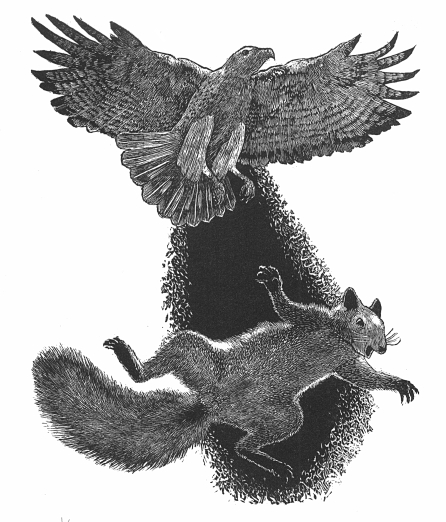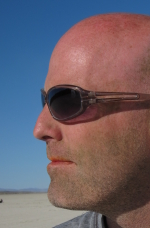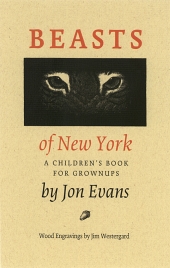The Porcupine's Quill
Celebrating forty years on the Main Street
of Erin Village, Wellington County
BOOKS IN PRINT
Beasts of New York by Jim Westergard and Jon Evans
A violent, epic, action-packed urban quest full of very eccentric, often hilarious, extremely dangerous characters who also happen to be animals -- the wildlife of New York City, to be exact.

Treachery leads to a monstrous war amongst the wildlife of New York City, and Patch, a young squirrel, is forced into exile on Staten Island. Patch must journey across deadly, human-ridden streets, parks and sewers to find his home in Central Park and to rescue all the animals from a power-hungry and sadistic enemy -- the King Beneath. Wood engravings by the award-winning Jim Westergard illuminate the scenes and the many animals that Patch encounters.

2012—ForeWord Magazine Book of the Year,
Commended
Patch knows something is direly wrong when all the squirrels in Central Park wake to find every foodstore stolen -- and, in the middle of winter, that means starvation. Patch’s mother is gone without a trace and in her den drifts a musky, unfamiliar scent. Hungry, tired and alone, Patch sets off into the ‘mountains,’ the human lands of New York City, to find food and to uncover what’s happening to his family.
He finds out too late that a war is brewing beneath his paws.
Patch is swept into an deadly battle that unites squirrels, birds, cats and dogs against vicious forces below the ground, rumoured to be led by the mysterious, legendary King Beneath. Gripping and suspenseful, Beasts of New York is a gritty urban fantasy populated by unforgettable characters as vivid and complicated as humans: from mercurial Zelina, the Queen of All Cats, to Snout, a massive and power-hungry rat, to Karmerruk, an arrogant, dangerous hawk.
Evans’s New York City of wildlife is deeply imagined; the urban landscape wavers between the familiar and the disturbingly bizarre, while Jim Westergard’s intricate wood engravings illuminate the settings and many characters. Evans, a master of dark crime thrillers, brings his fast-paced energy to an entirely new world -- one right under our feet.
Review quote
‘EPIC!
‘Beasts of New York is about a squirrel named Patch who, out of desperation and need, adventures beyond his home in Central Kingdom to try and save it. While it seems that fate is conspiring against him, taking him further from his home than any squirrel has traveled, his journey is a necessary step to saving all of Central Kingdom from the evil trying to consume it....
‘This book reads like a fantasy novel, even though it is set in New York City. The horrors that Patch encounters at times seemed so unreal to me, despite knowing where they were. Seeing them from another pair of eyes gave some things a new air of terror and others one of wonder.
‘This is not a light novel. It is very dark, and at times absolutely horrifying, but I connected so much to Patch as a hero that, in the end, I was left with tears of relief and happiness in my eyes.’
—Kate, GoodReads
Review quote
‘More than anything else, Evans’s book is about communication, physical, verbal, and instinctual; about gossip, eavesdropping, and a series of messages sent, received, misinterpreted, and mistimed. How his various creatures find their ‘‘voices’’ in their moments of need and manage to be understood by each other and their enemies is artfully imagined and constructed.
‘Through the eyes and hearts of Evans’s furry characters, Beasts of New York gets at a lot of complex stuff: issues of identity, specifically nature versus nurture, are explored without being heavy-handed, and the real-life distances between bravery and cowardice, loyalty and disloyalty, hope and despair are often revealed to be just a hair’s breadth apart.’
—Julie Eakin, ForeWord Magazine
Review quote
The best part about this book, though, is what saves Patch over and over from being preyed upon by bigger animals: his ability to communicate across the species barrier. Patch is able to speak bird, which earns him respect and memorability from the birds he encounters. It is because Patch is such an efficient communicator that allows him to make friends with the other animals he meets, who turn out to be helpful acquaintances in the long run.
Early on in the book, Evans speaks of animal communication, in that it is not made up of words or sounds, the way human language is. Instead, animals communicate with each other using a system of sounds, movements and body languages. As a human reader interpreting Patch’s discussions with other animals, I always got a kick out of what they would say to each other. When Patch meets a dog in the street, the dog strains to the end of his leash, shouting "Kill you and eat you! Kill you and eat you!" at Patch over and over. This made me giggle, as it’s pretty much exactly what I would imagine a dog would say to a squirrel in such a state!
Since reading Patch’s amazing adventure story, I have noticed that I now look at animals in a whole new way.
—Dana Deathe, Dana the Book Lady
Review quote
My initial reaction when I received Jon Evans’ Beasts of New York in the mail was, what a beautiful book! With the rise of e-reading, I’ve long believed that the future of print publishing is in books that are practically works of art. [...] So, when I saw the absolutely beautiful way Porcupine’s Quill printed Beasts of New York, I fell in love with the textured, cream-coloured pages and the ornate letters that opened each section. I also love the wood engravings by Jim Westergard. I was totally grossed out by the one of the rats, but overall, they’re beautiful. I love how realistic the fur looks, and am amazed whenever I remember that these images were originally created on wood. This book is a work of art, an example of the kind of reading experience e-books can’t offer (an image of a wood engraving on a screen will also be beautiful, but not quite as beautiful as on this type of paper, I think).
[...]I was afraid the book would end up being like a nature documentary. Luckily, however, the story becomes much more involved than that. I quickly became intrigued by Patch’s adventures, and loved seeing New York City through his eyes. Cars become "death machines" and apartment buildings are "mountains." In the hands of a lesser writer, I can imagine such descriptions being cutesy, but Evans pulls it off. At times, even I felt like I was traveling in a hostile, utterly alien environment, and I grew up in a city!
[...]Beasts of New York is a contemporary urban fable, geared for adults, but also a story that I think mature kids will appreciate. There aren’t a lot of adult books starring animals, and Evans’ animals seem less anthropomorphized than the books and movies I remember. Beasts is an exciting tale overall, and a beautiful, beautiful book.
—Jaclyn, Literary Treats
Previous review quote
‘Thought-provoking ... Invisible Armies is an intriguing, pacy read and Mr Evans shows great potential.’
—The Economist
Previous review quote
‘A sharp debut [Dark Places] that never lets up on the tension, with a denouement that is both shocking and utterly right ... Jon Evans ... isn’t about to develop into something special -- he’s already there.’
—January Magazine
Previous review quote
‘Reading Blood Price reminded me of being a kid running down a too-steep hill, going faster and faster so that you can barely get your feet in front of you quickly enough to stop, loving every second of it. You can’t stop. You don’t want to stop.... I wanted to keep reading to find out what the hell happened next’
—Quill & Quire
Discussion question for Reading Group Guide
1. Why do you think Evans chose to use animals for characters in his ‘children’s story for grown-ups’? How does his use of animals influence the progression of narrative? What is the nature of each species in Beasts of New York, and are there ever exceptions to these species’ average characteristics?
2. Above-ground and underground are often positioned as opposites in Beasts of New York. What do different heights signify? How are the animals’ personalities revealed by their interactions with the levels of a city? What possible symbolism lies behind the opposition of above- and underground?
3. How does this novel follow or uphold epic fantasy conventions? How does the novel challenge those conventions? If you were a bookseller, how would you categorize this novel in your store?
4. Evans intentionally changes his style of writing as the story progresses. Compare the first three chapters to the last three. What differences do you notice? How do these changes reflect Evans’s claim about Beasts of New York that it is a ‘children’s story for grown-ups’? Do you agree with this claim? Why do you think Evans believes this?
5. What does Patch realize about himself by the end of the story? How has he changed? Do you think Patch would have grown or developed in the way that he did regardless of the events in the story? Did Patch display any potential (for leadership, goodness, bravery, trickery, etc.) in the beginning, or did he only develop those traits as a result of hardship? What implications does your answer have for the concept of a hero’s journey?
6. Zelina, the Queen of All Cats, also changes dramatically over the course of the story. What do we learn about the nature of royalty through Zelina? What do we learn about the creation of identity? Do most of the characters in Beasts of New York undergo a similar transformation (in one way or another) as Zelina?
7. Most of Evans’s other novels are international thrillers. Can you see any hints of this in his style or theme in Beasts of New York? How do you think Evans’s previous thrillers influenced his telling of Beasts of New York?
8. Many reviewers mention that one of Beasts of New York’s most interesting aspects is its representation of the relationship between animals and humans. How do the various species view or interact with humans? Do you think there is an advocacy of environmentalism in Beasts of New York? Is this an environmentalist work? Why or why not?
9. Although the animals talk and feel emotions like humans, can you find any important differences between the animals’ thought processes and our own? Consider the animals’ attitudes towards love, death, tradition, family, and responsibility.
Excerpt from book
‘I think we should go,’ Toro said.
‘Not yet,’ Patch repeated. He watched the dust clouds in the pit, the way they moved. He didn’t want to be upwind of the rats. They too had sharp noses. He ran along the top of the fence, as far downwind as he could, and then he took a deep breath and ran straight down its side.
The lip of the pit was hard concrete, no good for downclimbing, but a wooden plank ran down into the shadows. Patch moved down this plank as quietly as he could; rats had sharp hearing, too. It was strange to walk on wood with such a perfectly straight surface. The pit was as deep as a medium-sized tree. About halfway down the plank he moved from sunlight into shadow, and his eyes began to adjust to his new surroundings.
The center of the pit was jumbled full of huge, geometric human things. Its bottom was crisscrossed by pipes and planks and girders. The floor and one wall of the pit were rocky earth rather than concrete. But it was in a corner between two concrete walls, towards the inside of the mountain, that he saw the unmistakable scuttling motion of a rat.
Patch crept closer, staying behind human things as much as possible. He reached a metal pipe that ran near the corner, and followed its length until the pipe ran into the concrete wall, just a half-dozen squirrel-lengths from the corner. He was still downwind, he thought, although it was difficult to read the wind down here. When he stood as high as he could he was just barely able to look over the pipe and see into the corner of the pit.
In that corner Patch saw something very strange. He saw a dozen large rats standing in a circle, all facing outwards, with all their tails knotted together in a big tangled lump in the middle of their circle. Standing on this lumpy knot of tails was Snout, the biggest rat of all. And next to this bizarre clump of rats, Patch saw, to his great surprise, another squirrel, small and with reddish fur.
‘Patch son of Silver,’ the strange squirrel said, and Patch stiffened. ‘I’ve heard of him. He’s of the Treetops. He talks to birds and goes off alone for days. I’m sure he doesn’t know anything. He just came to the mountains for the food.’
‘That’s not good enough,’ Snout said. ‘We will give him to Karmerruk.’
‘But --’ the squirrel began.
‘We will give him to Karmerruk.’
The name meant nothing to Patch, but it seemed to frighten the squirrel.
‘You said you would show me Jumper,’ the squirrel said hesitantly to Snout.
‘Oh, yes, Jumper,’ Snout said, and smiled, revealing jagged yellow teeth. Then, loudly, the rat commanded, ‘Bring him!’
There was a dark hole in the corner of the pit, near where the rats and the other squirrel stood. Patch saw motion in that hole. He saw a squirrel’s head emerge. He watched, shocked, as Jumper, lord of the Treetops tribe, crawled painfully out of that hole, his motions slow and spastic, and fell clumsily to the ground. Jumper was bleeding in many places, and he pulled himself along with his forelegs alone; both his hind legs hung motionless from his body. Several rats followed Jumper out of the hole.
‘Lord Jumper won’t be jumping any more,’ Snout said, and laughed.
Jumper pulled himself up on his forelegs. Patch could see he was in great pain.
‘Redeye,’ Jumper said in a ragged voice, to the squirrel who stood among the rats. ‘How can you have you done this?’
The other squirrel looked uneasy, and didn’t answer. Patch was glad to have his name. It was Redeye he had smelled in Silver’s drey.
‘He did it for me,’ Snout said. ‘He has sworn to serve me, as I have sworn to serve the King Beneath. The king in whose name you and all your kind will die and be devoured.’
Snout stepped away from the knot of rat-tails on which he stood. The knot began to squirm like a nest of worms as the rats untied themselves from one another. As they were released the rats formed into a tight circle around Jumper. Snout joined the circle. So did Redeye. Patch knew what would happen next. He didn’t want to watch. But it was too awful a thing to turn away from.
‘No,’ Jumper begged them. ‘No, please. Not like this.’
‘Yes,’ Snout hissed. ‘Exactly like this.’
And then they swarmed the crippled lord of the Treetops. Jumper howled three times before he fell silent beneath the frenzied mass of biting rats. Redeye seemed more rat than squirrel as he tore at Jumper’s body with his sharp fangs. In scarcely more time than it takes to tell it there was nothing left of Jumper but scraps, bones, and a puddle of blood. Even then the rats began to gnaw on Jumper’s bones and lick his blood. They would leave nothing of him at all.
Patch retreated silently to the wooden plank that led out of the pit. He felt colder than he had on the worst day of the winter. The squirrel Redeye had betrayed Jumper to rats, helped to kill him, helped to eat him. And Redeye’s scent had been in Silver’s drey. Patch climbed numbly into the sunlight, over the fence, back to the concrete, heedless of the passing humans and the death machines. They held scarcely any terror for him now; all he could think about was what he had seen in the pit below.
‘What did you see?’ Toro called out, from a tree. ‘What was down there?’
Patch said, ‘I have to go back to the Kingdom.’
Jim Westergard was born in Ogden, Utah in 1939. He was educated at a variety of colleges and universities in California, Arizona and Utah where he completed his BFA and MFA at Utah State. Westergard taught at Metropolitan State College and Northern Illinois University before moving to Alberta in 1975, where he taught at Red Deer College until his retirement in 1999. He became a Canadian citizen in 1980.
Jim Westergard has been creating prints from wood engravings since university days in the late 60s, but had never completed a book-length collection until the original limited letterpress edition of Mother Goose Eggs. The first engraving for this project was finished in 1999. Then, after a four-year struggle which included an unexpected hernia operation and reprinting the press-sheets a second time with helpful hints from Crispin Elsted of the Barbarian Press (Mission, BC), Mother Goose Eggs was finally bound and released in a deluxe edition of eighty copies in 2003.
Westergard continues to create wood engravings on his cantankerous old VanderCook SP-15 proof press which he has affectionately named the ’Spanish Fly’. His recent titles include Oddballs (Porcupine’s Quill, 2015) and See What I’m Saying? (Porcupine’s Quill, 2018).
For more information please visit the Author’s website »
Born and raised in Waterloo, Ontario, Jon Evans is the son of a Rhodesian expatriate father and a tenth-generation Canadian mother. He studied Electrical & Computer Engineering at the University of Waterloo, graduated in 1996, and promptly moved to California to work in the burgeoning software industry. Evans spent the next fourteen years working, writing, and travelling far and wide around the globe before finally returning to Canada in 2010 -- for now. Evans is the author of four thrillers, one graphic novel, and one dark urban fantasy, and his journalism has been published in Wired, The Guardian, Reader’s Digest and The Globe and Mail. His first novel, Dark Places, won the 2005 Arthur Ellis Award for Best First Novel. Evans currently lives in Toronto and at www.rezendi.com.
For more information please visit the Author’s website »
The Porcupine's Quill would like to acknowledge the support of the Ontario Arts Council and the Canada Council for the Arts for our publishing program. The financial support of the Government of Canada through the Canada Book Fund (CBF) is also gratefully acknowledged.






